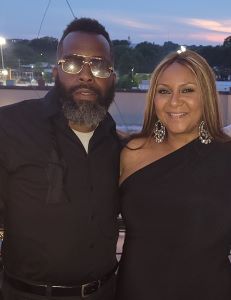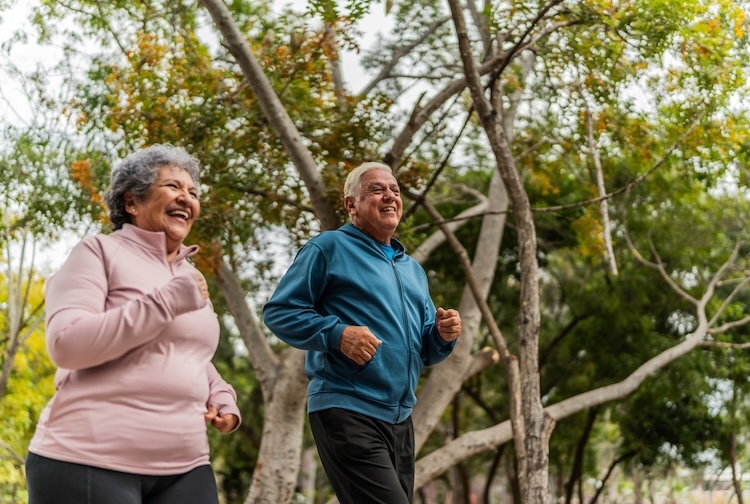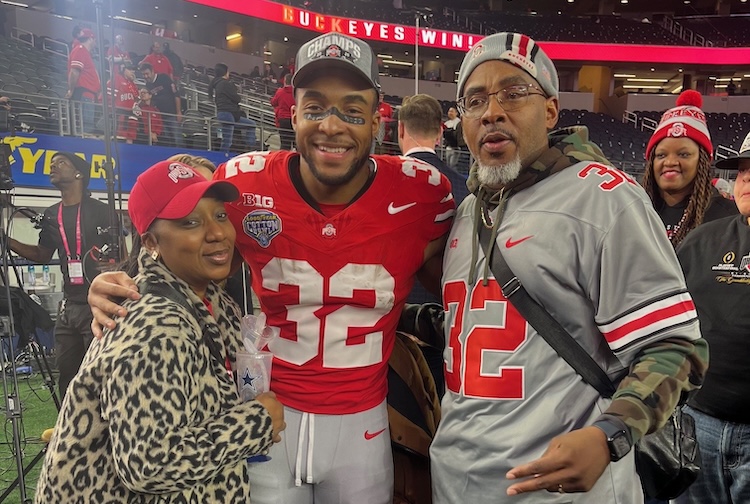Another record-breaking year in living donation: Why Hume-Lee excels
It's hard enough to get people to donate money to a worthy cause. But a kidney or liver? Hume-Lee accepts the challenge — and succeeds. Here's how.
April 08, 2022 Living liver donor Brent Luper and his mother, Karen Luper. Hume-Lee transplant surgeons successfully transplanted part of Brent's liver into his mom despite incompatible blood types.
Living liver donor Brent Luper and his mother, Karen Luper. Hume-Lee transplant surgeons successfully transplanted part of Brent's liver into his mom despite incompatible blood types.
By Esther Benenson
In 2021, VCU Health Hume-Lee Transplant Center continued its streak of record-breaking years — this time performing an astounding 494 transplants. The year before, it was 459. And before that, 434.
One reason behind the gains is Hume-Lee's successful living donor program. With a national wait list of 97,392 registrations for kidneys and 11,494 for livers, some people won't make it long enough to transplant.
That's not OK, say Hume-Lee staff.
Living donation can ease the shortfall
Hume-Lee performed 72 living-donor transplants last year — 53 kidneys, 19 livers. The benefits of using a living donor are many:
- The recipient gets an organ. There's no such guarantee when waiting for a deceased donor.
- The recipient spends less time on the wait list and doesn't have to get severely ill to rise to the top. Being that ill can rule out a transplant or increase the risk of complications.
- An organ from a living donor often functions longer than one from a deceased donor. Although an organ from a deceased donor can work for many years, an organ from a living donor comes from someone who's healthier. The donor organ will likely be in optimal condition.
But how do you get someone to donate?
When it comes to the recruitment, care and treatment of living donors, Hume-Lee excels.
“Donors are amazing people,” said Dr. Vinay Kumaran, surgical director of living donor liver transplantation at Hume-Lee. “It never ceases to astonish me that someone is willing to undergo major surgery to help someone else. And sometimes it's not even a close relationship. It's a friend. It's an in-law. It's an uncle. It's an aunt. And they're willing to have major surgery to save that person's life. I think they feel reassured when they're coming to a center which is doing these operations regularly.”
“The lab, the operating room, the HLA lab, the pharmacists — everyone that is taking care of our patients is amazing,” agreed Maureen Bell, living donor transplant coordinator. “But specific to living donor liver or living donor kidney, we have an amazing team of nephrologists, hepatologists and transplant surgeons who have just years and years of experience.”
Experience counts
Counting the years he spent as a living donor liver surgeon in India before arriving at Hume-Lee, Dr. Kumaran has performed more than 775 living donor liver procurements. In India, the majority of transplants are living donor transplants, he explained. “If we didn't have a living donor, the recipients wouldn't get an organ in time. In Delhi, our work was almost 99% living donor. In Mumbai, it was about 80%.“
Experience counts.
“When you've done that many cases, you've seen everything that can go wrong and how to deal with problems,” Kumaran said. “So I think they [the donors] feel reassured that we are unlikely to be fazed by whatever happens in the case.”
And something could go wrong, even in the best of circumstances. Liver transplant surgery is complex, both on the donor and the recipient end.
“One crucial aspect is we have to leave enough of the liver behind that it's safe for the donor. We have to take out enough that it's sufficient for the recipient. And we have to make sure that everything is well-supplied with blood, well-drained in terms of blood draining out of it, and it's suitable for reconstruction when we put it into the recipient,” Kumaran explained.
Having a living donor liver surgeon with as much experience as Dr. Kumaran is crucial to gaining trust — an underlying factor in securing living donors.
As one of two Hume-Lee living donor transplant coordinators, Bell is usually the first person the potential donor speaks to over the phone and meets in person. It's her job to convey to the donor the steps Hume-Lee takes to assure the safety of its living donors — beginning with their initial exams.
“The physical exam they get is going to be the best they've had in their entire life,” Bell said. “If we find anything that would potentially put their health at risk, they would be ruled out.”
Accessibility, responsiveness and a feel-good culture
Establishing trust is essential to building a positive relationship with donors, Bell said. Donors can call her, the doctors or the surgeons anytime. “We are always available to answer their questions. And that's during the evaluation, during the hospital stay, post-donation and five years down the road. We're going to be attentive and take care of whatever their questions are.”
“The more they learn from me, the more they learn about their evaluation, about the surgery, the hospital stay, their recovery, the less fearful they are, and the more motivated they are,” Bell said. “I am walking them through the journey. And I want it to be the best journey they've ever had in their life.
“I think the personal touch we offer is probably the prime difference between us and other centers,” said Dr. Dhiren Kumar, medical director of living donor kidney transplantation. “It's not a job to us. It's what we enjoy doing and what we enjoy looking forward to every day. It's doing whatever it takes to help our patients without thinking twice. That's the culture that we have over here.”
Innovation and determination
 As exciting as it is to have a living donor, the organ procurement team must be prepared for anatomical challenges. Such was the case with living donor Dionne Wynn-Criss, right, who wished to donate a kidney to her husband, Alteric “Al” Criss, in 2021.
As exciting as it is to have a living donor, the organ procurement team must be prepared for anatomical challenges. Such was the case with living donor Dionne Wynn-Criss, right, who wished to donate a kidney to her husband, Alteric “Al” Criss, in 2021.
Dionne had two arteries on each kidney, as opposed to the single artery most people have. The extra artery is known as an “accessory” artery. In addition, the lower artery on her left kidney was smaller than what most surgeons would prefer.
Many transplant centers will turn down the organ if there's an accessory artery, but the Hume-Lee transplant team knew what to do and successfully transplanted the donor kidney. Al and Dionne are both doing well.
And then there were the Lupers in 2020 — mother Karen Luper and son Brenton Luper. Hume-Lee was able to transplant a portion of Brenton's liver into his mother despite an incompatible blood type. Most transplant centers won't undertake such a transplant, assuming it would fail.
“We didn't have the luxury of waiting [for a deceased donor],” explained Dr. David Bruno, surgical director of adult and pediatric liver transplantation. “We were faced with a nearly impossible situation and had to overcome that in order to save Karen's life.”
The transplant was successful, and both donor and recipient are doing well.
“We have years and years of experience behind us, and we are constantly innovating,” Dr. Kumar said.
“We have unbelievably trained surgeons that successfully bring these patients to surgery with no complication,” Bell added.
Hume-Lee will also use living donors who are older than average. “Some transplant centers have an age limit of 65,” Bell said. “We have transplanted kidneys from donors in their seventies, and they did great. And they're back to their pre-donation activities — tennis, walking, working, golfing — everything they used to do. They had to go through a more significant workup, but they were medically cleared, and their recipients received a living donor kidney transplant. And they're doing just as well as the donor.”
Paired donation — another way to bypass the donor shortage
Hume-Lee participates in paired exchange programs with the National Kidney Registry and the Alliance for Paired Donation. A paired exchange occurs when the organ from a living donor is incompatible with the intended recipient — but it is compatible with someone else on the waiting list. If that person has a living donor ready to give, but they, too, don't match but someone else does, a “swap” can take place. The registries comb through the data until all transplant patients involved in the swap have a suitable donor.
“If there is an age mismatch between the donor and the recipient, if there is an immune system mismatch, or a blood type mismatch, we don't take that as a 'no',” Kumar said. “We look outside to find a suitable recipient for the donor and, and most importantly, a suitable donor for the recipient. If a recipient has a donor that qualifies, we will do anything to get them to transplant safely.”
Safety — a top priority
Hume-Lee surgeons meeting weekly to go over living donor anatomy and test results. Living donors must be medically cleared before they can donate. Donors must pass not only clinical tests but psychological evaluations. The team wants to make sure the donor understands the inherent risk of any type of surgery and make sure the donor isn't being pressured into donating.
 In terms of surgery, Hume-Lee surgeons use robot-assisted laparoscopic surgery to remove the donor kidney. The procedure results in a smaller incision, reduced blood loss, less pain and a shorter hospital stay for the donor. “It gets them back to their normal lives as soon as possible,” Dr. Kumar explained.
In terms of surgery, Hume-Lee surgeons use robot-assisted laparoscopic surgery to remove the donor kidney. The procedure results in a smaller incision, reduced blood loss, less pain and a shorter hospital stay for the donor. “It gets them back to their normal lives as soon as possible,” Dr. Kumar explained.
Leah Luongo, left, donated one of her kidneys to her husband and part of her liver to a friend. “They definitely have your best interest at heart," Leah said. "They are very well aware that you're putting yourself through a surgery that you absolutely have no medical reason for. They definitely take care of their donor.”
Positive feedback builds donor confidence
Hume-Lee holds quarterly Q/A sessions for potential donors to address questions concerning evaluation, surgery and recovery. A panel of living donors is always present to share their experience.
“Whenever we plan these sessions, we have people raise their hand to be on the panel and speak about their experience,” Bell said. “We get feedback from the people who attend the Q&As that they shed many a tear, a happy tear, that these people were willing to share their experiences.”
“I cannot think of working anywhere else,” Kumar said. “The feeling is unreal. I've been doing this for 10 years. It never gets old. Everybody working here is motivated towards one goal — getting our recipients and donors the best care possible.”
For information on how you can be a living donor, visit the VCU Health Hume-Lee Living Donor Program.
Sign Up for Transplant E-Newsletter




